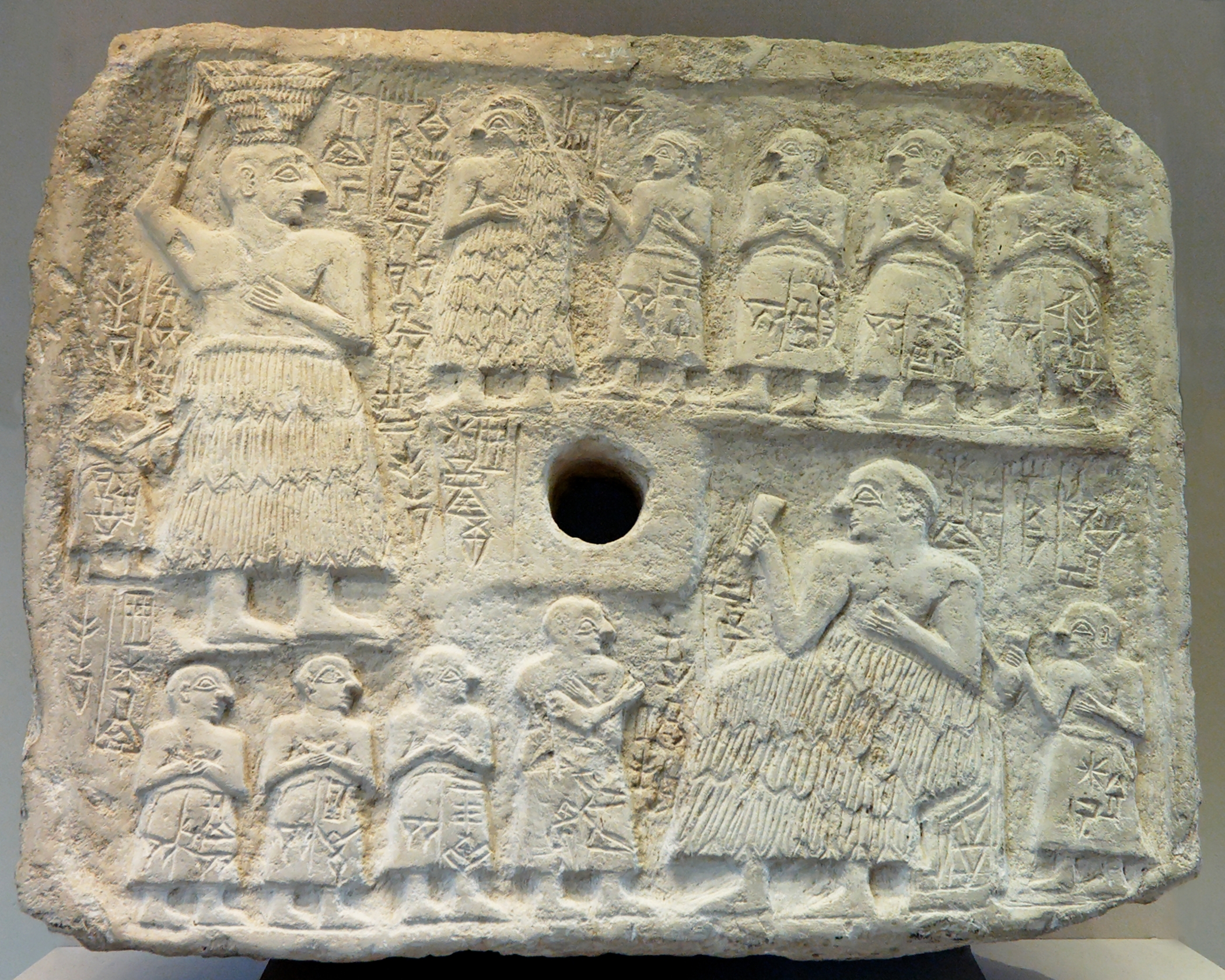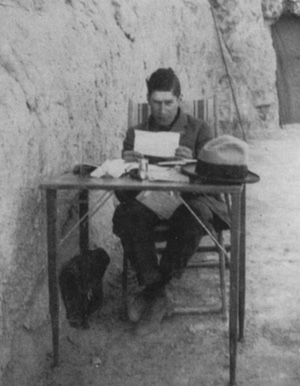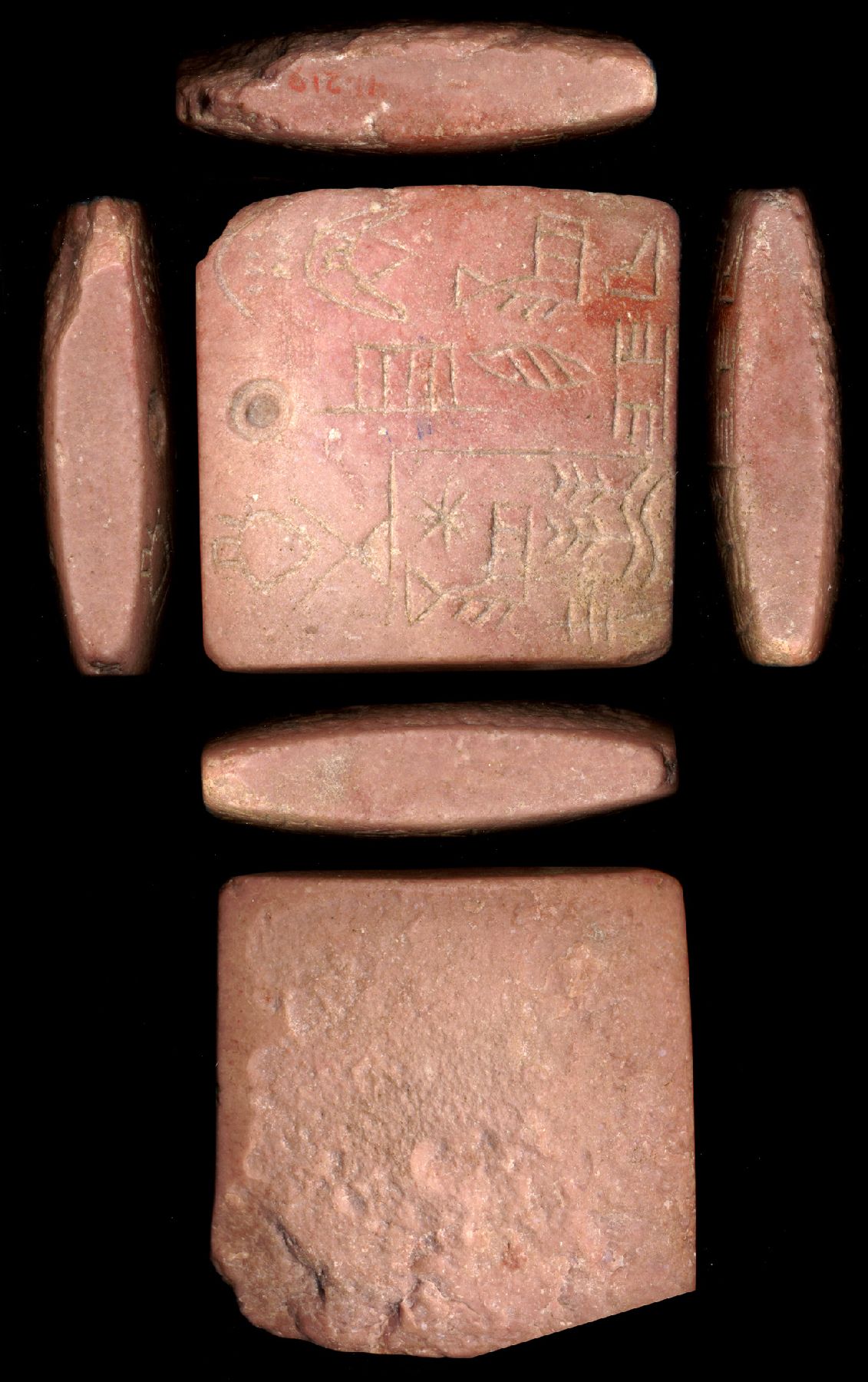|
Girsu
Girsu ( Sumerian ; cuneiform ) was a city of ancient Sumer, situated some northwest of Lagash, at the site of what is now Tell Telloh in Dhi Qar Governorate, Iraq. As the religious center of the kingdom of Lagash, it contained significant temples to the god Ningirsu ( E-ninnu) and his wife Bau and hosted multi-day festivals in their honor. History Girsu was possibly inhabited in the Ubaid period (5300-4800 BC), but significant levels of activity began in the Early Dynastic period (2900-2335 BC). At the time of Gudea, during the Second Dynasty of Lagash, Girsu became the capital of the Lagash kingdom and continued to be its religious center after political power had shifted to the city of Lagash. During the Ur III period, Girsu was a major administrative center for the empire. After the fall of Ur, Girsu declined in importance, but remained inhabited until . A 4th century BC bilingual Greek/Aramaic inscription was found there. Archaeology The site consists of two ma ... [...More Info...] [...Related Items...] OR: [Wikipedia] [Google] [Baidu] [Amazon] |
Lagash
Lagash (; cuneiform: LAGAŠKI; Sumerian language, Sumerian: ''Lagaš'') was an ancient city-state located northwest of the junction of the Euphrates and Tigris rivers and east of Uruk, about east of the modern town of Al-Shatrah, Iraq. Lagash (modern Al-Hiba in Dhi Qar Governorate) was one of the oldest cities of the Ancient Near East. The ancient site of Nina (Tell Zurghul) is around away and marks the southern limit of the state. Nearby Girsu (modern Telloh), about northwest of Lagash, was the religious center of the Lagash state. The Lagash state's main temple was the E-ninnu at Girsu, dedicated to the god Ningirsu. The Lagash state incorporated the ancient cities of Lagash, Girsu, Nina. History Though some Uruk period pottery shards were found in a surface survey, significant occupation at the site of Lagash began early in the 3rd Millennium BC, in the Early Dynastic Period (Mesopotamia), Early Dynastic I period (c. 2900–2600 BC), surface surveys and excavations show tha ... [...More Info...] [...Related Items...] OR: [Wikipedia] [Google] [Baidu] [Amazon] |
Early Dynastic Period Of Sumer
The Early Dynastic Period (abbreviated ED Period or ED) is an archaeological culture in Mesopotamia (modern-day Iraq) that is generally dated to and was preceded by the Uruk and Jemdet Nasr periods. It saw the development of writing and the formation of the first cities and states. The ED itself was characterized by the existence of multiple city-states: small states with a relatively simple structure that developed and solidified over time. This development ultimately led, directly after this period, to broad Mesopotamian unification under the rule of Sargon, the first monarch of the Akkadian Empire. Despite their political fragmentation, the ED city-states shared a relatively homogeneous material culture. Sumerian cities such as Uruk, Ur, Lagash, Umma, and Nippur located in Lower Mesopotamia were very powerful and influential. To the north and west stretched states centered on cities such as Kish, Mari, Nagar, and Ebla. The study of Central and Lower Mesopotamia has long ... [...More Info...] [...Related Items...] OR: [Wikipedia] [Google] [Baidu] [Amazon] |
Ningirsu
Ninĝirsu was a Mesopotamia, Mesopotamian god regarded as the tutelary deity of the city of Girsu, Ĝirsu, and as the chief god of the local pantheon of the state of Lagash. He shares many aspects with the god Ninurta. Ninĝirsu was identified as a local Hypostasis (philosophy and religion), hypostasis of Ninurta in a syncretism that is documented at the latest by the time of Gudea in the late third millennium BC. Assyriology, Assyriologists are divided on the question of whether they were originally two manifestations of the same god, or two separate deities. Ninĝirsu's two main aspects were that of a warlike god, and that of a god connected with agricultural fertility. In Lagash, he was particularly associated with a composite emblem depicting the Anzû bird over two lions. It could sometimes represent him in cultic contexts. Ninĝirsu was an important local god from the Early Dynastic Period (Mesopotamia), Early Dynastic Period until the Old Babylonian Empire, old Babylonian p ... [...More Info...] [...Related Items...] OR: [Wikipedia] [Google] [Baidu] [Amazon] |
Gudea
Gudea ( Sumerian: , ''Gu3-de2-a''; died 2124 BC) was a Sumerian ruler ('' ensi'') of the state of Lagash in Southern Mesopotamia, who ruled –2060 BC ( short chronology) or 2144–2124 BC ( middle chronology). He probably did not come from the city, but had married Ninalla, daughter of the ruler Ur-Baba (2164–2144 BC) of Lagash, thus gaining entrance to the royal house of Lagash. He was succeeded by his son Ur-Ningirsu II. Gudea ruled at a time when the center of Sumer was still ruled by the Gutian dynasty, and when the Akkadian king Ishtup-Ilum ruled to the north in Mari. Under Gudea, Lagash had a golden age, and seemed to enjoy a high level of independence from the Gutians, a language isolate speaking people who had arrived from regions to the northeast of Mesopotamia. Inscriptions Gudea chose the title of ''énsi'' (town-king or governor), not the more exalted ( Akkadian ''šarrum''). Gudea did not style himself "god of Lagash" as he was not deified during his own ... [...More Info...] [...Related Items...] OR: [Wikipedia] [Google] [Baidu] [Amazon] |
Bau (goddess)
Bau (cuneiform: 𒀭𒁀𒌑 ''dingir, dBa-U2''; also romanized as Baba or Babu) was a Mesopotamian goddess. The reading of her name is a subject of debate among researchers, though Bau is considered the conventional spelling today. While initially regarded simply as a life-giving deity, in some cases associated with the creation of mankind, over the course of the third and second millennia BCE she also acquired the role of a healing goddess. She could be described as a divine midwife. In art she could be depicted in the company of waterfowl or scorpions. In sources from Lagash and Girsu, Bau's husband was the god Ningirsu. Among their children were deities such as Igalim, Shulshaga and Ḫegir. While they could still be regarded as a couple in later sources, from the Old Babylonian period onwards Bau was also viewed as the wife of Zababa, the tutelary god of Kish (Sumer), Kish. Another deity associated with her was her attendant goddess Lammašaga. Most likely for political reas ... [...More Info...] [...Related Items...] OR: [Wikipedia] [Google] [Baidu] [Amazon] |
E-ninnu
The E-ninnu 𒂍𒐐 (House of 50) was the E (temple) to the warrior god Ningirsu in the Sumerian city of Girsu in southern Mesopotamia. Girsu was the religious centre of a state that was named Lagash after its most populous city, which lay 25 km (16 mi) southeast of Girsu. Rulers of Lagash who contributed to the structure of the E-ninnu included Ur-Nanshe of Lagash in the late 26th century BC, his grandson Eannatum in the following century, Urukagina in the 24th century and Gudea, ruler of Lagash in the mid 22nd century BC. The site has yielded inscribed bricks naming Ur-Nanshe and Eannatum, but most bricks date from the restoration effected by Gudea. The Gudea cylinders, perhaps the longest surviving text written in the Sumerian language, give a semi-mythical account of the building of the temple, along with a description of the rituals and symbols associated with E-ninnu. Some form of temple to Ningirsu probably existed from the early days of the city. Sumerian go ... [...More Info...] [...Related Items...] OR: [Wikipedia] [Google] [Baidu] [Amazon] |
Ninurta
Ninurta (: , possible meaning "Lord [of] Barley"), also known as Ninĝirsu (: , meaning "Lord [of] Girsu"), is an List of Mesopotamian deities, ancient Mesopotamian god associated with farming, healing, hunting, law, scribes, and war who was first worshipped in early Sumer. In the earliest records, he is a god of agriculture and healing, who cures humans of sicknesses and releases them from the power of Demons#Mesopotamia, demons. In later times, as Mesopotamia grew more militarized, he became a warrior deity, though he retained many of his earlier agricultural attributes. He was regarded as the son of the chief god Enlil and his main Cult (religious practice), cult center in Sumer was the Eshumesha temple in Nippur. Ninĝirsu was honored by Gudea, King Gudea of Lagash (ruled 2144–2124 BC), who rebuilt Ninĝirsu's temple in Lagash. Later, Ninurta became beloved by the Assyrians as a formidable warrior. The Assyrian king Ashurnasirpal II (ruled 883–859 BC) built a massive tem ... [...More Info...] [...Related Items...] OR: [Wikipedia] [Google] [Baidu] [Amazon] |
Nanshe
Nanshe ( ) was a Mesopotamian goddess in various contexts associated with the sea, marshlands, the animals inhabiting these biomes, namely bird and fish, as well as divination, dream interpretation, justice, social welfare, and certain administrative tasks. She was regarded as a daughter of Enki and sister of Ningirsu, while her husband was Nindara, who is otherwise little known. Other deities who belonged to her circle included her daughter Nin-MAR.KI, as well as Hendursaga, Dumuzi-abzu and Shul-utula. In Ur she was incorporated into the circle of Ningal, while in incantations she appears alongside Ningirima or Nammu. The oldest attestations of the worship of Nanshe come from the Uruk period. Her cult center was Tell Zurghul, known in antiquity as Nina. Another place associated with her, Sirara, was likely a sacred distrinct in this city. She was also worshiped elsewhere in the state of Lagash. Sanctuaries dedicated to her existed in its eponymous capital, as well as in ... [...More Info...] [...Related Items...] OR: [Wikipedia] [Google] [Baidu] [Amazon] |
Ubaid Period
The Ubaid period (c. 5500–3700 BC) is a prehistoric period of Mesopotamia. The name derives from Tell al-'Ubaid where the earliest large excavation of Ubaid period material was conducted initially in 1919 by Henry Hall, Leonard Woolley in 1922-1923, and later by Pinhas Delougaz in 1937.P. Delougaz, "A Short Investigation of the Temple at Al-’Ubaid", Iraq, vol. 5, pp. 1–11, 1938 Excavations continue into the present day. In Southern Mesopotamia, this period marks the earliest known human settlements on the alluvial plain, although it is likely earlier periods exist that are obscured under the alluvium. In the south it has a very long duration between about 5500 and 3800 BC when it is replaced by the Uruk period. In Northern Mesopotamia the period runs only between about 5300 and 4300 BC. It is preceded by the Halaf period and the Halaf-Ubaid Transitional period and succeeded by the Late Chalcolithic period. History of research The excavators of Eridu and Tell ... [...More Info...] [...Related Items...] OR: [Wikipedia] [Google] [Baidu] [Amazon] |
Stele Of The Vultures
The Stele of the Vultures is a monument from the Early Dynastic Period (Mesopotamia), Early Dynastic IIIb period (2600–2350 BC) in Mesopotamia celebrating a victory of the city-state of Lagash over its neighbour Umma. It shows various battle and religious scenes and is named after the vultures that can be seen in one of these scenes. The stele was originally carved out of a single slab of limestone, but only seven fragments are known to have survived up to the present day. The fragments were found at Girsu, Tello (ancient Girsu) in southern Iraq in the 1880s and are now on display in the Musée du Louvre, Louvre. The stele was erected as a monument to the victory of king Eannatum of Lagash over Ush, king of Umma. It is the earliest known war monument. Discovery The stele is not complete; only seven fragments are known today. The first three fragments were found during excavations in the early 1880s by the French archaeologist Ernest de Sarzec at the archaeological site of Girsu, ... [...More Info...] [...Related Items...] OR: [Wikipedia] [Google] [Baidu] [Amazon] |
Sumerian Language
Sumerian ) was the language of ancient Sumer. It is one of the List of languages by first written account, oldest attested languages, dating back to at least 2900 BC. It is a local language isolate that was spoken in ancient Mesopotamia, in the area that is modern-day Iraq, Iraq. Akkadian language, Akkadian, a Semitic languages, Semitic language, gradually replaced Sumerian as the primary spoken language in the area (the exact date is debated), but Sumerian continued to be used as a sacred, ceremonial, literary, and scientific language in Akkadian-speaking Mesopotamian states, such as Assyria and Babylonia, until the 1st century AD. Thereafter, it seems to have fallen into obscurity until the 19th century, when Assyriologists began Decipherment, deciphering the cuneiform inscriptions and excavated tablets that had been left by its speakers. In spite of its extinction, Sumerian exerted a significant influence on the languages of the area. The Cuneiform, cuneiform script, original ... [...More Info...] [...Related Items...] OR: [Wikipedia] [Google] [Baidu] [Amazon] |
Sumer
Sumer () is the earliest known civilization, located in the historical region of southern Mesopotamia (now south-central Iraq), emerging during the Chalcolithic and Early Bronze Age, early Bronze Ages between the sixth and fifth millennium BC. Like nearby Elam, it is one of the Cradle of civilization, cradles of civilization, along with ancient Egypt, Egypt, the Indus Valley Civilisation, Indus Valley, the Erligang culture of the Yellow River valley, Caral-Supe civilization, Caral-Supe, and Mesoamerica. Living along the valleys of the Tigris and Euphrates rivers, Sumerian farmers grew an abundance of grain and other crops, a surplus of which enabled them to form urban settlements. The world's earliest known texts come from the Sumerian cities of Uruk and Jemdet Nasr, and date to between , following a period of proto-writing . Name The term "Sumer" () comes from the Akkadian Empire, Akkadian name for the "Sumerians", the ancient non-Semitic languages, Semitic-speaking inhabitan ... [...More Info...] [...Related Items...] OR: [Wikipedia] [Google] [Baidu] [Amazon] |









